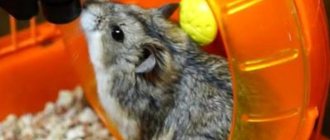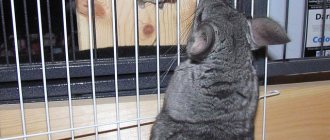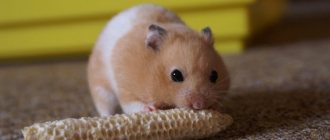Why does a hamster need a wheel?
A running wheel is a common and, according to some owners, a mandatory accessory to a hamster cage. The wheel allows the hamster to compensate for the need for exercise, even when living in a small cage.
Wild relatives of hamsters can walk 3–5 km in one night. Hamsters do not walk; they run most of the night, constantly changing their trajectory. No matter how large the cage is, no matter how much attention you pay to your pet, it is simply impossible to provide your hamster with such serious physical activity without additional accessories.
The wheel allows the hamster to run a sufficient distance without leaving the home and without spending a lot of time. Zoologists conducted research, the results of which were stunning. Adult females and males from the control group ran 7–8 km in one night. The increase in distance is due to the fact that domestic hamsters receive a complete diet and do not have the need to look for food; they can simply run and enjoy the exercise.
This is interesting! Hamsters that have the ability to run on a wheel are less likely to damage the cage and accessories in it, since they direct their energy in a peaceful direction.
Running is a physiological necessity for a hamster, allowing it to maintain healthy weight and muscle tone. With obesity, the heart muscle suffers first. It is for this reason that hamsters die earlier than their “sporting” counterparts.
We accustom the rodent to active activities
To train an animal, you can use the following trick. Place your pet's favorite treat on the trainer. To pick up the tasty treat, he will climb inside. Each time, place the treat higher and higher, then the animal will have to reach for it, and it will begin to spin the wheel. Over time, the hamster will learn to use it correctly. And don’t forget to reward the fluffy for every successful attempt.
If you fail to train the animal, try making the hamster run in a wheel. Lure the animal inside (to do this, put something tasty there) and cover the exit with cardboard or plywood. While exploring the available space, the baby will begin to rotate the simulator. And if it is suitable for your pet, then after several attempts the hamster will begin to independently climb into the structure and engage in “fitness”. Most rodents enjoy this activity. You can also initially help the animal by gently starting to spin the wheel. This way he will quickly understand what's what. In any case, be patient and give the animal time to get comfortable.
Why doesn't the hamster come to the wheel?
Have you bought a running wheel but your hamster completely ignores it? What could be the reasons?
Why does the hamster not come to the wheel:
- Size. Adult hamsters may ignore the wheel if its diameter is less than 16.5 cm.
- Unstable fastenings. The wheel should stand firmly and not loosen while running. If the wheel drum moves horizontally, the hamster feels insecure.
- Noise. Metal wheels, especially those that were purchased a long time ago, begin to make a lot of noise. Loud noises can be frightening to a hamster.
- Foreign smell. A hamster may ignore a new accessory if it is made of low-quality plastic and has an unpleasant odor. It is important to understand that a hamster’s sense of smell is much more acute than that of a human, so the owner may not be able to detect an unpleasant odor. An alarming odor may come from paint or grease on a metal wheel.
Important! If your hamster begins to ignore exercise, there is a high probability that he is not feeling well.
By refusing to run in a wheel, the pet shows that it is saving energy. If, while refusing to run in the wheel, you observe: deterioration in the condition of the coat, loss of appetite or general activity, immediately contact your veterinarian.
Finding out the reasons for the hamster's refusal
There are only two possible reasons for refusal:
- The age and health of the pet do not allow using the simulator.
- An animal does not run in a wheel because it is uncomfortable or does not like using it.
The first reason is simple. In the first two years of life, hamsters are very active. With age, animals become more clumsy and slow. If your pet is already old, do not force him to exercise. In any case, check your furry's health: deterioration in health often leads to decreased mobility and loss of interest in what is happening.
If the age and health of the hamster suggest a high level of physical activity, but there is no interest in the running wheel, the following reasons are possible.
- The simulator just recently appeared. Give your animal time to learn a new item.
- If after a few days your hamster is still not interested in the exercise machine, he may not be comfortable getting on it. Make sure that he can get on and off the wheel without any hindrance, and that his path is not blocked by a feeder, house, ladder or anything else. Remove objects that may block access to the accessory.
- Check the mounting level of the machine. Ideal location at floor level on the first floor of the cage. A higher position may be uncomfortable for the hamster.
- The wrong running wheel size is selected. For large hamsters, the optimal diameter is at least 18 cm, for Djungarian hamsters - at least 12, preferably 15-16 cm. If the wheel is small, it is uncomfortable for the animal to run in it; if it is too large, it is difficult for the baby to spin it, and the back may get tired.
- Check the reliability of the structure. Rocking and loud noises when using it can scare away the hamster for a long time. If the wheel squeaks, try lubricating the axle.
- Don't buy spoked or lattice wheels. Such simulators can easily injure a hamster’s paw, discouraging the desire to approach a dangerous object for a long time. The ideal option is a solid wheel. Pay attention to the material from which the exercise machine is made. Some animals prefer metal structures, others prefer plastic.
If all the conditions are met, but there is no result, try teaching your hamster to run in a wheel. Perhaps he simply did not understand what the new accessory was for.
How to train your pet to exercise
If the device was purchased recently and installed in a cage in compliance with all necessary conditions and recommendations, you should wait a few days, i.e. Give your pet time to get used to the device. After this, the animal should become interested in the simulator.
If the rodent stubbornly does not start using the device, or has stopped using it for an inexplicable reason, you can try to train the hamster to the wheel. You can do this in two ways:
- Using your pet's favorite food. Knowing the gastronomic and taste preferences of your furry pet is already half the success. You can find out about them simply by observing your little pet. Once the tasty secret weapon is known, you can begin training. To do this, you need to place the animal’s favorite treat inside the wheel. Then all that remains is to observe again. The aroma of the treat will make the hamster climb into the wheel to get the coveted prize. Treats should be provided until the hamster learns to run. Each time the food should be placed a little higher than before. Such a maneuver will provoke the animal to strive to climb up and turn the running circle.
- By blocking the exit. If the treat trick doesn't bring much results, you can use the blocking method. To do this, you need to cover the entrance hole with a piece of cardboard or plywood while the hamster is inside the simulator. Once in a confined space, the animal will find that it cannot get out and will diligently search for an opportunity to get out. In search of a loophole, the hamster will begin to move along the wheel. Once he has completed his run, he can be released. The process must be repeated several times and each of them must certainly end with a run. Soon the rodent will get involved and will happily jog even with an open exit.
Age-related changes
As a hamster ages, a white spot may appear on its eye. This disease is called cataract, it is characteristic of mammals. With it, the lens of the eye becomes cloudy, often in the pupil area, sometimes around the perimeter. First a gray spot appears, then it turns white over time. This particular disease in rodents cannot be cured.
Cataracts can be caused by stress, eye trauma, and spots can also appear as a result of other diseases, for example. food poisoning. In the Djungarian hamster - as a result of diabetes mellitus. Constant sun can also provoke the appearance of this disease: the cage cannot be kept in the sun all the time.
There are recommendations that you can follow to avoid developing the disease:
- do not keep the cage in the sun;
- do not feed the animal sweet treats;
- give your hamster a lot of plant foods: carrots, greens, zucchini and others;
- do not cause eye diseases and treat in a timely manner.
Sometimes hamsters have a congenital cataract. Hamsters don’t see very well anyway, and a thorn will interfere even more. To prevent your pet from getting hurt due to poor visibility, make the cage more spacious and do not put many objects in there.
As others have said, hamsters have poor vision, so do everything you can to avoid making it worse. A good owner will definitely keep an eye on this. You just need to monitor the cleanliness and nutrition of your pet and sometimes study it, and of course, give care and love.
What I am a master at is talking incessantly about hamsters. I have three hamsters at home, and my husband has a pet rat. That’s how we live, the six of us eat, the six of us sleep :)
Why does a hamster refuse to run?
The main reasons why the animal does not run on a wheel are as follows:
- The design is unreliable. It is worth conducting a thorough inspection of the simulator and making sure that it is correctly mounted, assembled securely and the device is stable. If the structure is shaky, it must be secured firmly and securely. If there are large gaps between the steps, you need to lay a circular track made of cardboard on the running surface, which will prevent the furry runner's paws from falling through and getting stuck between the rungs and will protect him.
- The location of the structure is inconvenient. The height of the placement should correspond to the height of the animal so that it is convenient for the hamster to climb inside the structure. It is important to make sure that there are no obstacles on the pet’s way to the simulator - if the animal is in the way of bowls or a resting house, then they need to be moved so that access to the simulator is free.
- The size of the simulator does not correspond to the dimensions of the rodent. The diameter of the wheel should allow the animal to move freely inside the simulator. If the diameter is too small in relation to the dimensions of the hamster, then the animal will be cramped inside such a structure. The diameter of the running circle for a dwarf hamster should be from 12 cm, and for a Syrian hamster – from 18 cm.
- The hamster does not like the material of the trainer. There are no recommendations for this case - preferences depend on the individual. Some hamsters love products made of plastic, others - metal.
- The device makes a lot of noise when rotating. The loud squeak that a metal running wheel can make frightens the animal and depresses it. For silent rotation, you need to lightly lubricate the mechanism with vegetable oil.
- There is a risk of injury. If the design is not well thought out or does not suit the animal, it may get injured when using the simulator. A hamster that hits itself or has its paw pinched will lose the desire to use the dangerous exercise machine. If the design cannot be adjusted, the simulator will have to be replaced.
- The rodent is weakened due to illness or advanced age. For these reasons, you should not force your pet to train, lure him into the wheel with treats, etc.
Conclusion
To train a hamster on a running wheel, you need to choose an accessory that suits your pet. Proper selection and installation increases the chances that the animal will use it. However, even this does not guarantee success. A hamster's refusal to turn the wheel is a rare phenomenon, but it does occur. If, despite the efforts of the owners, the animal ignores the running wheel, provide the pet with physical activity using a walking ball. Be attentive to your little furry, then you will be able to understand what he needs for a full and healthy life.
A little about ferrets
Recently, more and more often animal lovers choose a ferret as a pet. This animal is very funny, cute and to some extent exotic. And this choice is quite logical. Firstly, ferrets are very cheerful creatures, you won’t get bored with them, there is no end in sight to the games and fun. Secondly, the ferrets are very compact, for some this is a significant advantage, since they can be very easily transported on various trips.
Ferrets, despite the fact that they are nocturnal animals, can quite easily adapt to the life rhythm of their owner. There is no need for daily walks with these animals, like, for example, with dogs. If you decide to take your ferret for a walk, getting him accustomed to a harness won’t cause much trouble. They treat the owner friendly, get used to it well, unlike cats, but without fanaticism, like dogs. It is also worth noting that ferrets are distinguished by their extraordinary inquisitiveness of mind, intelligence and cunning.
Among representatives of the same species, you can find animals with completely different manifestations of character, therefore, you can choose a more suitable type for yourself, from super active to calmer.











